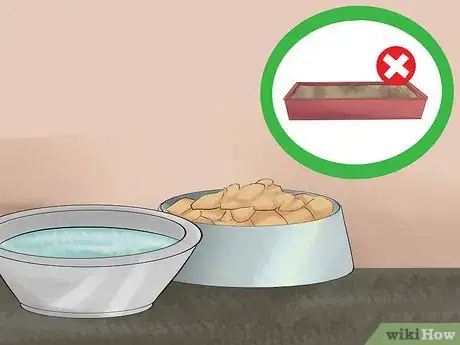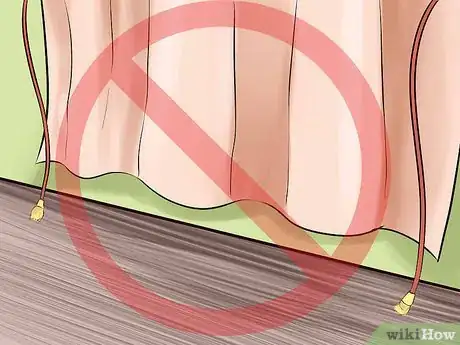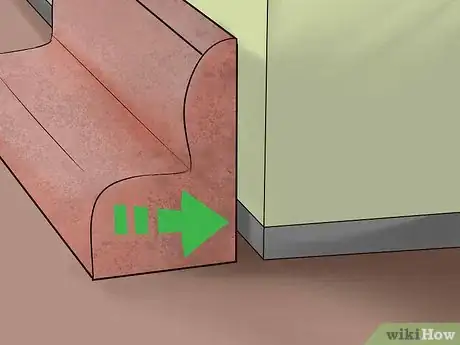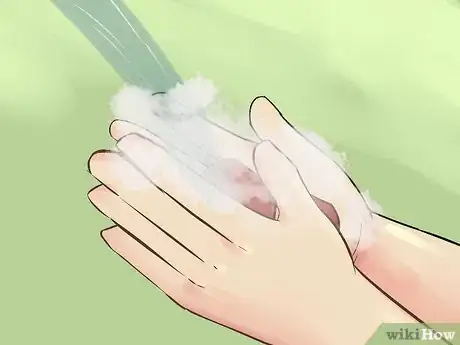This article was co-authored by Pippa Elliott, MRCVS. Dr. Elliott, BVMS, MRCVS is a veterinarian with over 30 years of experience in veterinary surgery and companion animal practice. She graduated from the University of Glasgow in 1987 with a degree in veterinary medicine and surgery. She has worked at the same animal clinic in her hometown for over 20 years.
There are 14 references cited in this article, which can be found at the bottom of the page.
This article has been viewed 69,804 times.
The sight of a kitten is irresistible. They're also instinctively clean, will grow up to be independent, and don't need to be housebroken. For these and other reasons, they're popular as adoptive pets. However, you can't just pop down to the shelter and adopt on a whim. Becoming a kitten parent involves assessing your readiness and preparing your home before going through the adoption process. Once you meet and bond with your new little friend, you'll realize it's worth the effort.
Steps
Assessing Your Readiness to Adopt
-
1Make sure you can bring a cat into your home. This should go without saying, but too many people abandon animals because they didn't realize their living conditions were unfriendly to pets. If you're a renter, read over the terms of your lease regarding companion animals. If they are allowed, ask your landlord if your rent will be increased.
- Make sure no one in your household is allergic to cats. If someone is allergic, make sure they can manage their allergies before bringing a furry friend into the home.[1]
- You can also consider adopting an allergy-friendly breed. These cats don't let loose as much dander as other breeds and are less likely to trigger allergies. However, there is no such thing as a totally hypoallergenic cat.
-
2Weigh the responsibilities. While adult cats are independent, kittens don't like to be alone for too long. If you live alone, think about who will feed your cat if you have to work late or go away on business. Ask yourself if you're willing to clean the litter box at least daily and give the cat regular brushings. Even with regular brushings, cats shed regularly. This means you'll need to vacuum about once to twice a week.
- If you don't live alone, you'll need to ask your housemates (significant other, children, flatmates, etc.) if they're willing to help with the responsibilities. If you have children, you could add feedings and brushings to their chores.[2]
Advertisement -
3Make sure you have enough money. Many shelters take care of the first check-up, microchipping, and spaying/neutering. However, you'll need to set money aside for yearly examinations and vaccinations. If you plan on letting your cat outside, you'll need to budget for heartworm prevention. You'll also need to consider the expenses involved in buying food, treats, and cat litter. If you have to be away from home often, you should also consider the cost of a trusted cat sitter.
- Consider insuring your pet against unforeseen health expenses.
Making Your Home Kitten-Friendly
-
1Buy cat litter and a litter box. Since kittens can be sensitive to harsh chemicals and other pollutants, opt for dust-free litter that won't irritate young eyes or lungs. If possible, try litter made from natural materials, like corn husks or shredded newspaper. Some natural brands come in a convenient clumping formula.[3]
- Litter boxes come in a wide variety from simple pans to self-cleaning facilities. Since cats have an instinct to excrete in dirt or sand, you don't need to litter box-train your new kitten. You will need to place the litter box in a quiet room away from the heaviest activity. The bathroom is a popular choice.[4]
-
2Purchase bowls for food and water. Kittens need their own food bowls, even if they'll be sharing your home with older “siblings.” This is because cats tend to be territorial and can lash out at the new kitten if they try to “steal” food. Many food bowls have 2 compartments, 1 for wet food and 1 for dry. You can choose from plastic, metal, or ceramic. You'll also need to buy a separate bowl for water.
- Keep the food and water bowls away from the litter box, since cats don't like their food and waste in the same location. Choose a different room. For example, if the litter box is in the bathroom, put the food and water bowls in the kitchen.[5]
-
3Buy kitten food. Because kittens are still growing, they need food with the nutrients that can take care of their needs. Make sure the food is specially formulated for kittens. Compare the label with adult cat food. Make sure the kitten food is higher in calories (for energy) and DHA (for nervous system growth). Buy both canned and dry food so that your little one will get used to both.
- Stick to brands that test their food with the Association of American Feed Control Officials (AAFCO) or their non-U.S. equivalents. These brands are more expensive, but they're more nutritious and will put your kitten at a lower risk for illness later in life.[6]
-
4Purchase a cat carrier. You'll need one not only to take your new family member home but also for visits to the vet and other outings. Make sure you buy a carrier for an adult cat to avoid having to buy a larger one later. You can find carriers at pet supply stores and big box stores.
-
5Place perches by the windows. Cats of all ages love to survey the outdoors for birds, squirrels, and other woodland creatures. Provide a perching area by at least a few windows to give your cat a variety of viewing angles. You can buy perches in pet supply stores or big box stores. They come in a wide variety, ranging from padded extensions for your window sill to floor-to-ceiling cat “trees” with multiple perching levels.[7]
-
6Provide at least 1 scratching post. Cats need to file their nails to prevent them from growing into the pads of their feet. Satisfy this need with scratching posts in the rooms you think your cat will spend the most time in. Scratching posts come in a variety of forms from simple and lightweight to large and complex. Some even come with catnip that draw the cat to the post—and away from your furniture.[8]
- You can also scratch-proof your furniture if you think your cat might be tempted. Apply double-sided tape or upside down carpet runners to your furniture. If you opt for carpet runners, make sure the knobby side is facing up.[9]
-
7Remove strangulation hazards. Anything that dangles can strangle your cat. This includes vertical blinds, curtain/shade cords, and pooling curtains. Tie up any long cords to a height that would be out of reach to a kitten. Consider replacing your blinds and long curtains with safer alternatives like window shades and horizontal blinds.[10]
-
8Check for easily overlooked hazards. Kittens love to explore and can find dangerous objects if you're not proactive. Search for loose change, rubber bands, or anything else that might pose a danger to your cat. Look under and behind furniture, in between cushions, and in small open areas between furniture and walls.
- If you can, close up any small spaces by pushing your furniture or appliances as close to the wall as possible. Tiny bodies can easily get stuck in these areas.[11]
-
9Replace poisonous plants. Plants like lilies, poinsettias, tulips, and azaleas are highly toxic and can kill your cat. Opt instead for non-toxic plants like African violet, yellow rocket, or bamboo. For a complete list of toxic and non-toxic plants, check out the American Society for the Prevention of Cruelty to Animals (ASPCA).[12]
Adopting Your Kitten
-
1Go to your local animal shelter. Always adopt from a shelter. Cats end up in shelters due to abandonment, the illness/death of a past owner, and a variety of other reasons, but rarely because they're “damaged.” All they need are good, loving homes. Because animals are often euthanized to make room for new arrivals, you'll save a life when you adopt a shelter kitten.[13]
-
2Fill out the application. Applications often ask for your identifying info like your full name, address, and phone number. In many cases, you'll be asked for a photo ID to verify this information. You'll also have to provide information about other animals living in your home and the dates of their most recent vaccinations. Answer all questions honestly. This is to protect the kitten's safety.[14]
-
3Interact with the cats. Wash your hands before handling each one so that you don't spread disease to them. Be open-minded and find a cat that you feel will be a good fit for you and your family. Pick them up, play with them, and pet them. Each cat is different and has different personalities. If a cat is shy or sleepy at that moment it could just be that time of day or they may not be too used to humans. Don't try to force anything.
- If you share your home with other people, bring them to the shelter with you. It's important that the entire household get involved in the decision.[15]
-
4Honor the waiting period. Many shelters require prospective pet parents to wait at least 24 hours before they can bring their little one home. This is to give you extra time to think about your decision to adopt and discuss it with others in your household. If you reconsider, you can back out without any penalties. During the waiting period, the shelter will put a hold on the kitten you chose to prevent someone else from adopting them.[16]
-
5Complete the contract. Most shelter contracts ask that you commit to spaying/neutering the kitten if that hasn't been taken care of. You'll also agree to keep them properly fed and vaccinated, not use them for experimentation or other forms of cruelty, and will return them to the shelter if you can't provide proper care. Other terms include swearing that you have no history of cruelty to animals and will allow shelter employees to visit from time to time.[17]
-
6Pay the adoption fee. Adoption fees can range from $100 to $300 and upwards. They usually include any medical care the kitten received while at the shelter, as well as transportation costs from their first home. It also helps to cover the costs of care for the animals still awaiting forever homes.[18]
- Shelters always appreciate it if you chip in a little extra money as a donation. Every little bit helps to keep animals alive.[19]
-
7Bring your kitten home. Place the carrier in a quiet room. Don't force the cat to come out. Instead, let them choose to come out and investigate on their own. Give them space and time to adjust to this new environment. Most kittens will need 1 to 2 weeks to get used to their new home.[20]
Warnings
- Most apartment complexes have a limit of how many cats you can have in an apartment. Examine and acknowledge your complexes limits.⧼thumbs_response⧽
- Never buy a kitten (or any animal, for that matter) from a pet store. These animals are often bred in inhumane conditions for the purpose of profit. As a result, they're often sick or deformed. Not buying animals from pet stores or malls also helps in shutting down these businesses. Many of these animals are bred against their will and then dumped on the streets to fend for themselves[21]⧼thumbs_response⧽
- Animal hoarding is unsanitary and inhumane. If you have too many cats, your state/national health and safety officials might come to your home and require that you reduce the number of cats you have. The limit is usually 10.[22]⧼thumbs_response⧽
- Never declaw your cat. Declawing is like chopping off your finger at the last knuckle. In other words, it's painful and crippling. To avoid damage to your furniture and your skin, keep your cat's claws properly trimmed.[23]⧼thumbs_response⧽
References
- ↑ https://www.petfinder.com/cats/living-with-your-cat/cats-for-allergy-sufferers/
- ↑ https://www.aspca.org/adopt-pet/adoption-tips
- ↑ http://www.drsfostersmith.com/pic/article.cfm?articleid=2026
- ↑ http://www.peteducation.com/article.cfm?c=1+2137&aid=3288
- ↑ http://www.villagevets.com/index.php?page=new-kitten-care
- ↑ http://www.petmd.com/cat/centers/nutrition/slideshows/tips-for-choosing-kitten-food
- ↑ https://www.petfinder.com/pet-adoption/cat-adoption/cat-adoption-first-30-days/
- ↑ https://www.petfinder.com/pet-adoption/cat-adoption/cat-adoption-first-30-days/
- ↑ https://www.aspca.org/pet-care/cat-care/common-cat-behavior-issues/destructive-scratching
- ↑ https://www.aspca.org/adopt-pet/adoption-tips
- ↑ https://icatcare.org/advice/household-hazards
- ↑ https://www.aspca.org/pet-care/animal-poison-control/cats-plant-list
- ↑ http://www.peteducation.com/article.cfm?c=1+2137&aid=829
- ↑ http://www.peteducation.com/article.cfm?c=1+2137&aid=829
- ↑ http://www.peteducation.com/article.cfm?c=1+2137&aid=829
- ↑ http://www.peteducation.com/article.cfm?c=1+2137&aid=829
- ↑ http://www.peteducation.com/article.cfm?c=1+2137&aid=829
- ↑ http://www.peteducation.com/article.cfm?c=1+2137&aid=829
- ↑ http://www.peteducation.com/article.cfm?c=1+2137&aid=829
- ↑ https://www.petfinder.com/pet-adoption/cat-adoption/cat-adoption-first-30-days/
- ↑ https://www.petfinder.com/pet-adoption/pet-adoption-information/buying-puppies-and-kittens/
- ↑ https://www.aspca.org/animal-cruelty/animal-hoarding
- ↑ https://www.petfinder.com/pet-adoption/cat-adoption/when-adopting-cat/
About This Article
To adopt a kitten, start by going to your local animal shelter and filling out an application. When filling out the application, be prepared to provide a photo ID, answer questions about any other animals living in the house, and the dates of their most recent vaccinations. Next, interact with the kittens until you find one that seems like a good fit for you and your family. Once you find the right kitten, complete any paperwork the shelter may require, pay the adoption fees, and prepare to take your new kitten home! For more tips from our Veterinary reviewer, including how to prepare your home for your kitten, keep reading!













































































